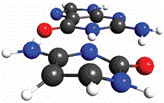Department of Chemistry
Date of this Version
7-2010
Document Type
Article
Abstract
Analytic gradient of the combined conductorlike polarizable continuum model (CPCM) and time-dependent density functional theory method is derived and implemented. Due to the use of the fixed points with variable areas tessellation scheme, the excited state potential energy surfaces (PESs) are rigorously continuous and smooth. The CPCM/TD-B3LYP method is used to study an analog of the photoactive yellow protein chromophore, anionic thiomethyl p-coumaric acid (TMpCA−). Although CPCM/TD-B3LYP method may not be accurate in predicting solvent effect on vertical excitation of TMpCA−, it may be used to predict redshiftings of emission maxima relative to absorption maxima with an accuracy of ~0.1 eV. We also found that the excited trans-TMpCA− tends to form a single bond twisted structure in the gas phase but a double bond twisted structure in aqueous solution. The TD-B3LYP minimum energy isomerization pathway shows a barrier of 3.6 kcal/mol in aqueous solution and 5.2 kcal/mol in the gas phase. The gas phase double bond twisted structure is trapped in a well of the excited state PES, with a depth of ~20 kcal/mol (0.88 eV), in good agreement with an experimental value of ~1 eV.


Comments
Published in THE JOURNAL OF CHEMICAL PHYSICS 133, 034108 (2010); doi:10.1063/1.3462248 Copyright © 2010 American Institute of Physics. Used by permission.